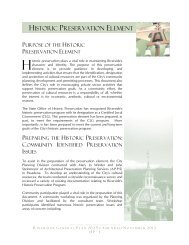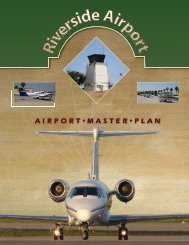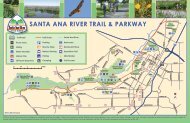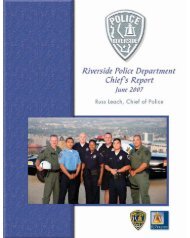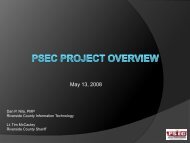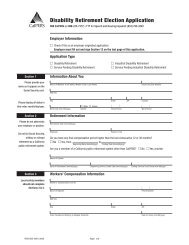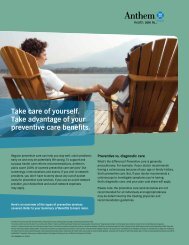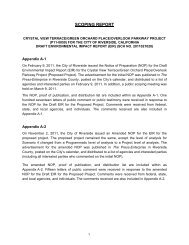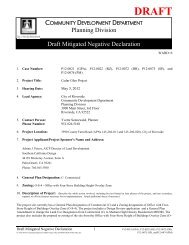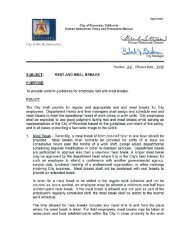Northside - City of Riverside
Northside - City of Riverside
Northside - City of Riverside
Create successful ePaper yourself
Turn your PDF publications into a flip-book with our unique Google optimized e-Paper software.
COMMUNITY DEVELOPMENT<br />
Early residents <strong>of</strong> the <strong>Northside</strong> enjoyed many neighborhood places and spaces <strong>of</strong><br />
informal recreation, but three areas <strong>of</strong> organized recreation within the historic<br />
boundaries <strong>of</strong> the <strong>Northside</strong> <strong>of</strong>fered facilities and attractions that also drew<br />
participants from downtown and, sometimes, beyond. Athletic Park was located<br />
within the survey boundaries while White Sulphur Springs and Fairmount Park<br />
border the survey area, but their significance to residents within the <strong>Northside</strong><br />
warrants inclusion here. Only Fairmount Park is still in use as a public park, but is<br />
now drawn outside the <strong>City</strong>’s newly perceived boundaries <strong>of</strong> the <strong>Northside</strong>, whose<br />
southern boundary is increasingly recognized as SR-60.<br />
White Sulphur Springs<br />
Since 1876, thousands <strong>of</strong> <strong>Riverside</strong>rs as well as local and eastern visitors have<br />
enjoyed the waters <strong>of</strong> a natural hot spring captured for use as a bathing and<br />
swimming plunge. White Sulphur Springs, a name that has changed many times, is<br />
located at 3723-25 Strong Street, near Main Street, just north <strong>of</strong> the survey area.<br />
Historic accounts indicate that the property was either more extensive or was<br />
considered to be located on North Orange Street.<br />
First used by local Native Americans, likely Cahuillas and Gabrieliños, the natural<br />
hot springs and adjacent tulle bog were purchased by Dr. James P. Greves, a<br />
Founding Father and <strong>Riverside</strong>’s first postmaster, in 1876 for their alleged medicinal<br />
and curative properties. It was in 1886 that William Elliott, a newcomer from Illinois,<br />
acquired the springs and capitalized on its healthful and recreational potential. By<br />
1896, Elliott sank the first well on the property and began construction on a plunge<br />
to capture the natural mineral waters. The <strong>Riverside</strong> Press and Horticulturist (RP&H)<br />
reports that by September 1897, Elliott was still in the process <strong>of</strong> improving the<br />
property and indicates that the undertaking may have been in response to a public<br />
clamoring for specific recreation facilities:<br />
Some months ago we alluded to the question <strong>of</strong> a public bath and<br />
picnic grounds, and the matter has been agitated considerably on the<br />
streets. And we believe we voice the sentiments <strong>of</strong> every man, woman,<br />
and child in <strong>Riverside</strong> when we say that the necessity <strong>of</strong> a good system<br />
<strong>of</strong> plunge and swimming baths is almost imperative ( RP&H 1897:n.p.).<br />
By May 1898, RP&H reports that the 40x60-foot natatorium, or swimming pool, was<br />
complete and that the construction <strong>of</strong> a glass-ro<strong>of</strong>ed building housing 60 dressing<br />
rooms, galleries, <strong>of</strong>fices, and more was planned and funded by the sale <strong>of</strong> advanced<br />
tickets, indicating the popularity <strong>of</strong> and demand for such a facility.<br />
53



